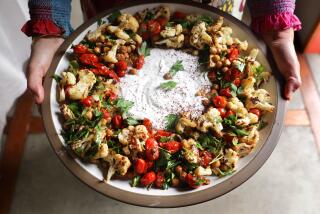GARDEN FRESH : Call Me Kale
- Share via
What if I invited you to dinner, you accepted, and then I said, “. . . and I’m making my favorite dish of kale. . . .” Would you suddenly remember your Aunt Maude was due in town that night?
But had I said, “. . . and I’m making a salad of warm purplish peacock kale with shreds of Gruyere cheese, balsamic vinegar and toasted pine nuts,” Maudie might be persuaded to stay home.
Now, when did you last tuck delicate leaves of summer kale into a tossed salad? Or dress hot ribbons of frost-sweetened kale with olive oil and lemon juice and serve them with garlic toast?
Some of you are nodding and smiling and saying, “Yesterday!” From a sheltered place or from the cold frame you may have picked smooth, blue-green leaves of Lacinato, the mildly flavored Italian heirloom kale. Or oak-leaf purple-veined leaves of Red Russian (a.k.a. Ragged Jack), a delicious American heirloom that reddens, like children’s cheeks, in the cold. Or perhaps you harvested young crimson leaves from the center of a Chidori ornamental kale that looked like crinkly roses bordered with green.
Perhaps you’re planning to order ornamental red and white peacock kales to sow in summer. They make an extraordinarily lacy spray in the border, stalks of cream or rosy purple etched with blue-gray-green. Plucked young, their leaves are delicious. Arranged as garnish on a platter, peacock kale looks like something between exotic feathers and a Martian doily.
*
Although it’s not as showy, you kale cognoscenti know the value of the savoyed green culinary kale most of us see--nay, overlook--at the market. Have you a patch of it, with leaves ready to chop into a cream sauce as filling for green lasagna? Have you tried Verdura, a Dutch strain with succulent, dark, blue-green leaves (tastiest kale I’ve tasted). In the garden, curly kale looks like giant ruffled parsley.
Kale is a cool-season vegetable; it grows and tastes best when temperatures are in the 50s and 60s, as they are now. Most kales are even happy in the 40s and 30s. And a few sharp frosts deepen their colors and intensify their sweetness.
The best timing is to start heirloom culinary kale seeds around July and hybrid ornamental kales in August, so plants can be going strong by September or October. These kales will winter over, and likely be harvestable through February. Some plants may give you delectable leaves for another year. Some may yellow in spring and send up flowers. These buds are like broccoli, so cook them up!
In gardens where there is little or no frost, you must choose a kale that grows tender and sweet without the cold. Try Dwarf Blue Curled Vates, a culinary kale with finely curled blue-green leaves. Place it in your chilliest spot. When you pick the leaves, refrigerate them in the crisper for a few days, and you’ll gain some of frost’s effects.
In the High Desert, sow Dwarf Blue Curled Vates in February and March. Where seasons are short, sow seeds in May and June.
*
But even where summers are warm, sow a few seeds of Red Russian kale in very early spring. Give plants a coolish spot and you can harvest before the heat, even during it. It’s worked for me.
Harvest young leaves individually with a knife, taking them from near the center. Let the mature leaves stay.
As you can imagine, kales have few rivals for beauty in the border. From 12 inches to 24 inches tall and usually just as wide, springtime kales like the company of daffodils and irises. Autumn kales love partying with marigolds.
Kales are easy to grow. They need five hours of sunshine daily, an inch of water weekly and shelter from wind. All must have well-drained, moisture-retentive soil. Green sorts want a fertile soil to give their best, both in vigor and nutrition. In lean soil, the struggle to overcome deficiencies actually makes ornamental kales grow brighter.
Kale is susceptible to aphids. Swoosh them off with a hose (but be careful not to break the leaves). Past that, if there are signs of damage, consult a county agricultural agent. And let three years pass before you grow kale in the same place again. This helps prevent disease and provides an even drain on the soil’s resources.
*
Ah, but not just to look at, these are plants to eat! Kale is among the most nourishing of vegetables. One serving gives twice the RDA of vitamins A and C, and healthy amounts of readily available calcium and iron. Also, kale leaves don’t shrink in cooking the way spinach and chard leaves do, so you don’t have to harvest buckets for a meal.
When the time comes that you must take up the whole plant, peel the thick main stem, unless it’s old and tough. You can cut it into matchsticks and treat as you would celery.
So-called Chinese kale, by the way, isn’t the familiar European sort of kale but a kissing cousin.
Speaking of China, it’s exciting to know that the rose quartz, ruby, amethyst, ivory and jade of ornamental kales adorn gardens all over the Orient and across Europe and Britain. I wish I could tell you that the kales from these gardens come into kitchens and are sent to tables in splendor. But I can’t because they don’t--and aren’t.
Only Portugal, Scotland, Ireland, a corner in the north of Italy and pockets in Holland appreciate kale properly. The national dish of Portugal is kale and potato soup-- caldo verde . Irish cooks mix finely chopped kale with mashed potatoes and spoon it up with pools of butter--colcannon (which is also made with cabbage). In Scotland, kale is simmered in stock and the soup is thickened with barley, oats or rice--kale brose. An Italian spoon-stands-up-in-it soup of white beans, pasta, tomatoes and garlic is given depth of color and taste with rags of kale-- pasta e fagioli verdi. And wearing a Greek cap, I turn a broth speckled with kale into a lemon-tangy egg-creamy avgolemono.
So it’s up to us to rouse the gardeners of the world into growing and eating kale!
*
Let’s begin with a dish inspired by a Dutch classic. It’s wonderful when you can have intriguing shapes of leaves in front of you. How many cooked leaves can you think of that are more than a nebulous heap on the plate? Kale leaves, whether deeply cut or nattily curled, are sculpture.
If you have sensational sausages--something like the designer chicken and turkey I found the other day made with “fire-roasted red peppers, cilantro, spices, and garlic”--you can give this to friends for supper. Pass a basket of radishes, black olives and carrot sticks. Drink a Dutch lager. Let mellow Edam cheese follow. Then for dessert, chopped candied ginger pressed into the icing of a bittersweet chocolate cake.
And best invite Aunt Maude . . . .
Sources
Fresh: Curly and ornamental kales at markets with fine produce, and perhaps Red Russian at farmers markets.
Mail-order seeds: “Red & White Peacock”--listed under Flowering Cabbage and Kale--from Thompson & Morgan, Box 1308, Jackson, N.J. 08527-0308. “Dwarf Blue Curled Vates” from Lockhart Seeds, Box 1361, Stockton, Calif. 95205. All others mentioned from Shepherd’s, 6116 Highway 9, Felton, Calif. 95018.
*
Peacock kales wilt rapidly once picked, so cook them ASAP. But don’t cook in a skillet, even with moisture. The leaves will turn drab and tough. Boiling them in a pot of water intensifies their hues and renders them tender. Unfortunately, unless the leaves are very young, the stalks are too fibrous to enjoy.
To prepare and cook kale (and other leaves with tough stalks), swish in lots of cold water. If home-grown, soak 30 minutes to float any aphids, then rinse well again. Fold each leaf lengthwise. Run a sharp knife along the inside of the stalk, freeing the pair of greens. Leave greens whole or chop as desired; if stalks are tender, chop and cook separately. This is less a soup than a meal in one with its broth. Add more broth if you’d like it soupier.
DUTCH SAUSAGES AND POTATOES IN PEACOCK’S BROTH
6 cups cold water
1 pound unpeeled small red potatoes, cut into 1-inch chunks
1 pound tender peacock leaves or other kale
1 quart beef broth
1 pound richly flavored lean ready-to-eat sausages, sliced 1/4-inch thick
Salt
Freshly ground pepper
Dash nutmeg
Coarse ground mustard
Bring cold water to boil in broad heavy saucepan. Set potatoes in steaming basket over water, cover and steam until tender.
Meanwhile, remove stalks from kale. Chop greens roughly (if tender, save stalks for another time).
When potatoes are cooked, remove in basket. Add beef broth to steaming liquor and bring to boil. Drop in kale leaves, pushing beneath broth. Simmer, uncovered, over medium heat until nearly tender. Thin ornamental leaves about 7 minutes, peacock and Red Russian leaves about 10 minutes, thicker curled leaves about 25 minutes. Stir occasionally.
Add sausages and potatoes to pot. Cover, turn heat to low and simmer until sausages are plump, about 6 minutes more. Season to taste with salt and pepper. Sprinkle over nutmeg. Serve in flat soup plates, passing coarse mustard on side. Makes 4 main dish servings.
Each serving contains about:
427 calories; 1,827 mg sodium; 57 mg cholesterol; 25 grams fat; 34 grams carbohydrates; 20 grams protein; 2.18 grams fiber.
More to Read
Eat your way across L.A.
Get our weekly Tasting Notes newsletter for reviews, news and more.
You may occasionally receive promotional content from the Los Angeles Times.










